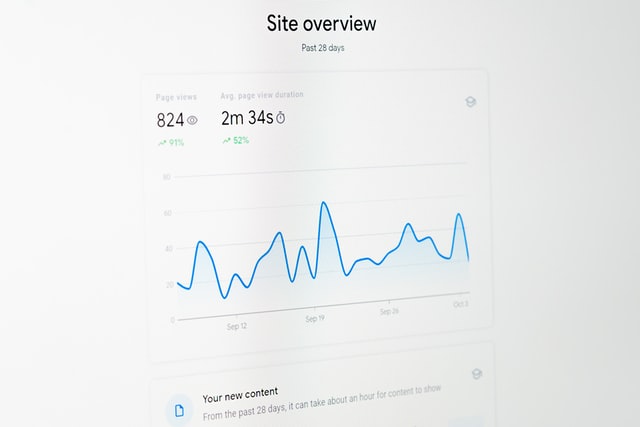Why should you add GA4 (Google Analytics 4) to your website?

Tanel Vetik
Head of Strategy
It was nearly 3 years ago when Google announced the news that they’re working on a new analytics platform, called Google Analytics 4 (GA4). A few months ago, we also received a detailed timeline of the launch, and details of how GA4’s predecessor – Universal Analytics (UA) – will be phased out in June of 2023.

When listening to feedback from other marketing specialists, there’s both excitement and confusion in the air. The phasing out of Universal Analytics comes much sooner than was anticipated, as the current Google Analytics 4 version is still very much a work in progress.
The main reason for this launch is to stay ahead of Google’s website analytics competition, which is closing in at an unprecedented speed.
Why should you add GA4 (Google Analytics 4) to your website?

Tanel Vetik
Head of Strategy
Pea kolm aastat tagasi teatas Google, et on töötamas oma uusima analüütika tööriista kallal – Google Analytics 4 (GA4). Ning paar kuud tagasi saime ajakava, mille lõpus GA4 eelkäija Universal Analytics (UA) 2023. aasta juulikuus kinni pannakse.
Turundajate silmis tuli see otsus oodatust varem, ning õhus on tunne, nagu tormaks Google poolvalmis tootega turule.
Eesmärgiks on konkureerivate analüütika programmide ees konkurentsis püsimine.

It was nearly 3 years ago when Google announced the news that they’re working on a new analytics platform, called Google Analytics 4 (GA4). A few months ago, we also received a detailed timeline of the launch, and details of how GA4’s predecessor – Universal Analytics (UA) – will be phased out in June of 2023.

When listening to feedback from other marketing specialists, there’s both excitement and confusion in the air. The phasing out of Universal Analytics comes much sooner than was anticipated, as the current Google Analytics 4 version is still very much a work in progress.
The main reason for this launch is to stay ahead of Google’s website analytics competition, which is closing in at an unprecedented speed.
Save the date – which dates should you look out for
Google are saying that by July 2023 (in just about 12 months’ time) all Universal Analytics (UA) properties will stop processing new data on your website. GA360 properties got a 3-month extension, scheduled to end processing new data by October.
It means that if you have no other website analytics tools installed on your website (you only have Universal Analytics), then you will have no data reporting from July 2023.
Google are also saying that you will be able to access your historic data on Universal Analytics for another 6 months. Starting in 2024, they will delete all UA properties, Universal Analytics historic data. Third-party data processing tools (e.g., Google Looker Studio, Supermetrics, Funnel.io) will not be able to access any of your UA data.
Google have not officially stated, if there are any plans to retain that historic data. It has instead been hinted that a full-scale deletion will take place. The likely reason behind this is to have businesses integrate to GA4 as quickly as possible, and to save server space by removing UA data.
But why are Google investing millions to develop a new analytics platform?
When comparing Universal Analytics to the new Google Analytics 4 interface, there are some very clear differences (apart from the sharp learning curve – whoever designed the user interface should probably be fired). Maybe the biggest two are how GA4 can measure events and engagement on apps, while UA could not. The second big difference is how conversion events are set up on the website with Google Tag Manager. Universal Analytics allowed you to do this easily, using simple integrations and setting up ecommerce tracking took about 5 minutes. GA4 is not so simple, as all conversion events need to be manually assigned to the correct GA4 Property and ecommerce tracking requires a custom set up that can take hours to set up. Especially for Google Ads campaigns.
It’s unlikely that Google created this monster of an analytics platform just to annoy marketeers around the world. There is a real, profitable reason behind this development. If we look at when Google Analytics started, it was 2005. Web analytics was a nascent business that promised immense value – which was true, it did become valuable. But what was not foreseen was the crackdown on personal privacy in the last decade. Google launched Universal Analytics in 2012 (8 years before iOS 14), when mainstream smartphones did not use cookie-blockers, most business owners didn’t even think about third party cookies, and most consumers weren’t too worried about website tracking. Times were different.
In those 10 years we saw tremendous change in the way website tracking was being used. Universal Analytics relied on session-based tracking, which worked fine in its own time. With cookie-blockers, it started acting up and reported inaccurate data. Marketeers started preferring other analytics platforms to Universal Analytics, causing Google to lose access to valuable data. The need for a more up to date analytics platform was growing to become the elephant in the room.
Google Analytics 4 relies on events-based tracking. Instead of tracking just sessions + conversions, we are looking for individual actions (called events in GA4). Surprisingly, GA4 offers higher user privacy, while also granting more detailed insight into what’s happening on the website. It does not keep track of the IP address, for example.
Though, this has not been a welcomed change by many marketeers because Google butchered the launch. They launched a half-finished product to allow its users to do the interface testing for them (they saved millions by having users test this platform for free by having them submit customer complaint forms, detailing what could be better). While clever, it created a bad reputation for GA4 before it even launched.
What should you do today?
The good news is that you have one year to set everything up before Universal Analytics gets phased out. Though, it’s recommended to set it up as early as possible. Google have also stated that all historic UA data will be deleted – without historic data you won’t be able to make comparisons. By having GA4 measure your website today, you’ll be able to draft year-on-year graphs when UA shuts down.
Best to be prepared.
Let us try and make your life a bit simpler by showing a step-by-step guide on how to set up Google Analytics 4 on your website.
How to install Google Analytics 4 on your website
- When using Universal Analytics, create a new Google Analytics 4 Property in the Admin view of your current Google Analytics account.
It’s recommended to use Google Tag Manager here, as it allows you to later set up conversions all in one place. Install Google Tag Manager on your website, create a new tag to configure Google Analytics 4, add the trigger most suitable for your measurement purposes, publish.
- Activate Enhanced Measurement in your Google Analytics 4 Settings.
This already includes some events like page scrolling, outbound link clicks, searches made on the website and video views/clicks. In Universal Analytics, these events had to be set up manually.
Start measuring events on your webpage, using Google Tag Manager.
All events are divided into four categories:
- Automatically Collected Events
- Enhanced Measurement Events
- Recommended Events
- Custom Events
You should definitely keep in mind that all events created in Google Tag Manager get sent to Google Analytics 4 automatically, but the parameters do not. You need to configure them separately.
You need to do this in your Google Analytics Events view. The purchase event is automatically marked as a conversion, but you’re free choose the conversions most suitable for your business.
If you feel like the automatically generated conversions don’t represent your measurement needs, you should set up ned events in Google Tag Manager, send them to your GA4 Property, and mark them as conversions.
- Set up eCommerce tracking (if this is relevant for our business)
If you’re using data layers to capture ecommerce data in your online store for Universal Analytics, then that same data will no longer be accepted for Google Analytics 4. Luckily, there’s a section in Google Tag Manager (in the template gallery) where you can import the necessary setup. Look for “GA4 Ecommerce to Enhanced Ecommerce Converter” variable and it could easily be the solution you need.
Other ecommerce variables will be covered by events and triggers. Such as add_to_cart, begin_checkout, purchase, subscribe, apply_coupon etc.
- Build your custom reports in the Explore section
When building custom reports in Universal Analytics was important for your data analytics needs, then those same features have now moved over to the “Explore” section. Here you can apply data filters, build custom graphs, blend data, build pivot tables, and much more. It’s a bit more sophisticated than what we saw in UA. The learning curve is not excessively steep either.
If you feel like moving all your data and website tracking from UA over to GA4 is too difficult to grasp, then Google have created lots of helpful tutorials and pages to try and make it as easy as possible. Please do keep in mind that because UA and A4 track data slightly differently, then moving over to GA4 could be a great opportunity to overhaul the entire data tracking system of your website and integrate GA4 holistically to everything else. Your CRM and email software, for example.
Also, have a think about which data you really need, what you want to report on, and what is most important to understand business success. I recommend opting for more practical data over nice to know numbers.
A few thoughts before letting you off here
Don’t overthink this – there’s still time to move your data over to GA4. Although please don’t leave it last minute and don’t be late with the integration. The sooner you migrate your data over to GA4, the more historic data you will have. Google have stated that they will remove Universal Analytics data from their servers, and you will not have access to it at some point. If you don’t have any historic data, then you won’t be able to compare 2024 to 2023 and that could be bad.
Most businesses that we work with have already migrated over to GA4, but most have not gone a step further to fully integrate it to their data measurement/reporting systems. This includes granular conversion tracking. We’re helping them sort all this out before the deadline comes.
The easiest way to get this done is to just mark a day in your calendar and dedicate that day to migrate your UA data and tracking over to GA4. It won’t get easier, and it won’t get done by itself. It’s important to do it as early as possible to have the most accurate data set for 2023 as you can. When your competitors are struggling with this, you have it all sorted out and your data set is populating with valuable insight. They won’t have this, and it will be your competitive edge.
I’m talking a lot about GA4 vs UA in this piece, but there are several other competent data analysis platforms to choose from. Their biggest downside is the monthly fee (they are rarely free, and the free plan is usually quite limited). Another thing is their potential data security risk. Hacking Google is a lot harder than hacking a much smaller business.
2022 is a very good year to assess your data tracking strategy and find the best solutions. Otherwise, you may find yourself stressing out and having to put out analytics fires in about 18 months’ time.
I’m also adding a very useful analytics migration guide created by Google, just in case. It has additional links to useful articles to help you on this (quite tedious) journey.
Naturally, you can also contact us with any Universal Analytics (UA) and GA4 questions, and we can help with conversion setup, optimization, and training.
